1969 Ford Talladega and Mercury Cyclone Spoiler II; Fact Sheet

Because we have so many pages of information devoted to the Talladega and Spoiler II cars we have developed an entire site devoted to just these cars. In addition that site includes the first ONLINE REGISTRY FOR THE 1969 FORD TALLADEGA, 1969 MERCURY CYCLONE SPOILER AND SPOILER II, THE 1969 MERCURY CYCLONE COLOR CODE CARS PLUS THE 1968 MERCURY CYCLONE GT 500 CARS (simply click here). We encourage you to visit that site as well as use the Search feature on this site to find out more about these rare and desirable cars.
General History
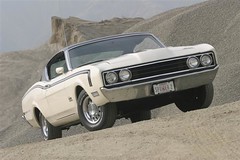 It was 1969. The Stones, “Honky Tonk Woman” was one of the top ten songs along with “Get Back,” by The Beatles and “Sugar, Sugar,” by the Archies. Richard Nixon was President, a house could be bought for $40,000.00. Milk was $1.26 and gas 36 cents a gallon! A postage stamp cost $0.06 and the average income was $8,547.00. (Were those the days, or what!)
It was 1969. The Stones, “Honky Tonk Woman” was one of the top ten songs along with “Get Back,” by The Beatles and “Sugar, Sugar,” by the Archies. Richard Nixon was President, a house could be bought for $40,000.00. Milk was $1.26 and gas 36 cents a gallon! A postage stamp cost $0.06 and the average income was $8,547.00. (Were those the days, or what!)
Ford and Mercury were racing in NASCAR and wanted to win more races. Unlike today, in 1969 NASCAR meant race cars were Stock Cars! They were all built from cars straight off the show room floor or their counterparts. 1969 was the time of AERO WARS on the high speed NASCAR tracks. The factories were in to manufacturing some pretty wild cars just to win on Sunday and sell on Monday. It also meant that if the manufacturer wanted to race it, they had to build it and sell it to the public. This resulted in the Ford Talladega, Dodge Daytona, Plymouth Super Bird and the Mercury Cyclone Spoiler II. NASCAR mandated that at least 500 of each car be manufactured to qualify for racing.
The big winged Dodge Daytona and Plymouth Superbird are arguably the most famous of the aero cars that raced in NASCAR but were they the first? NO!
The 1969 Ford Talladega and Mercury Cyclone Spoiler II were the Blue Oval’s designation for cars with the extended sheet metal on the nose. In this report we will focus on the Ford cars but we will deal with the MOPARs on another page.
 Ford Talladega Prototype, Banjo Matthews Car
Ford Talladega Prototype, Banjo Matthews Car
 Last Talladega Built, Click Here
Last Talladega Built, Click Here
Mercury Spoiler II
To build 500 such cars was a tall order for Mercury; each Cyclone Spoiler II had 19.5 inches of new sheet metal added to the front of the car. The entire front end was cut off just In front of the front tires and an entirely new, sloped nose was grafted to the original fenders. These cars were all hand built. Many believe the Ford Talladega and the Mercury Cyclone Spoiler II are identical. In fact the Talladega had only 15.5 inches added to its nose. The Spoiler II’s nose is not only longer it is also built at a steeper 35-degrees vs the Talladega’s 30-degrees. At high speeds these differences actually made the Spoiler II from 2 to 8 mph faster than the Talladega. Most also believe the Talladega and Spoiler II have identical bodies, this also is not true. The only shared components between the cars are their bumpers, grilles, and turn signals!
This is a Spoiler II fender with all of the paint removed. You can see the original seams.
Thanks to Wayne Perkins for this excellent photo of his Spoiler II under restoration.
This is an original Spoiler II with the seam marked with blue tape. The metal to the left is the new aero metal. Notice how close the bumper sits to the fender compared to the standard production model.
This is a restored Spoiler with the correct “W” nose fender. The blue tape marks the location where the factory cut the original fender to add the new aero metal.
This is a Ford Talladega with the seam marked with blue tape. The extended nose is in front of the tape.
This is a full view of the Spoiler II’s extended fender.
As stated earlier, NASCAR mandated that at least 500 of these hand built extended nose cars had to be manufactured. According to the Official Cyclone Spoiler Registry, Mercury built only 351 out of a reported 503 units. How did they do that? They built 351 extended “D” nosed cars; parked them in the front of a parking lot; took 152 regular “W” nosed Cyclone Spoilers and parked them in the back of the same parking lot. When NASCAR counted the cars they just never looked closely enough at the cars in the rear!
Can you see the “W” in the nose of the standard factory Cyclone? Note that the hood is the end of the front end.
Now look at this Spoiler II with the extended nose; call the “D” nose or “long nose”. The panel in front of the hood was custom built and added by the factory. The blue line represents were the old sheet metal was cut off and the new aero metal added by the factory.
Note how similar this Talladega front end appears to be to the Spoiler II. In fact they are distinctly different and share no sheet metal between them.
This is a photo of the Cale Yarborough Spoiler II NASCAR race car.
However, the Marti Report states that there were 503 actual Spoiler built. Ford/Mercury records from that time are not the best. We even have letters from Ford stating that the VINs for our three Talladega are actually for Mustangs. They later corrected this error but it demonstrates the potential errors that exist in such data from “back in the day”.
Mercury built two versions of both the Spoiler (W nose) and Spoiler II (long nose) one was a Dan Gurney Special and the other a Cale Yarborough Special.
The Gurney Special will be Blue and White while the Yarborough Special will be Red and White.
Only the Spoiler had a scoop and hood pins. No Spoiler II or Talladega should have scoops or hood pins. They were never available on these cars.
Both the Spoiler and Spoiler II should have a rear wing. However, these were dealer installed and some were never installed. Most were painted in a non-gloss black but a very few Gurney cars have been documented to have Blue Spoilers when new. It is unknown if there were painted at the factory or by the dealer.
If you assume the 503 number is correct, the total production was divided between two cars; a portion were Cale Yarborough Specials (285) and the remainder were Dan Gurney Specials (218). If you assume only 351 Spoiler IIs were ever built and you use the same ratio of Yarborough and Gurney cars then it can be estimated that only 199 Cale Yarborough and 152 Dan Gurney Spoiler II’s were ever built. The official Cyclone Spoiler Registry, in 1992, found only 42 Cale Yarborough and 35 Dan Gurney cars were known to still exist.
TALLADEGA
So, what do you think of when you hear the word “Talladega”? Obviously for fans of NASCAR the track in Alabama comes to mind. But for those that remember a certain factory modified 1969 Ford Torino, Talladega is a rare car that brings back exciting memories of the fabulous NASCAR aero-wars of the late 60s and early 70s on the Super Speedways.
Trying to save face the Dodge Boys, having been shown up by the newly introduced in 1968 Ford Fairlane fastback body style, decided the 1969 Dodge Charger needed to be a little more aerodynamic. The result was the beautiful limited production 1969 Dodge Charger 500. With a flush mounted grill and reworked rear window it had less aero drag, which is a huge benefit on the super speedways. However, the Dodge Boys were so excited about their new discovery they weren’t too good about making it a surprise to the rest of the racing community. Hearing what the Dodge Boys were up to, Ford went back to the drawing boards with its 1969 Torino fastback. They brought in outside help from factory backed race shop Holman and Moody. These guys were wizards and came up with some aerodynamic tricks for the already slippery Ford and Mercury fastbacks.
The wheel shown on this Talladega could have been installed at the dealer but is not correct from the factory. All Talladegas came from the factory with white wall tires! All Spoiler IIs had white letter tires. On the Spoiler the tire and wheel combinations could be anything on the option list.
Here is the correct wheel for all Talladegas and Spoiler IIs.
Not how close the grill is to the front of the car on this Talladega, a Spoiler II should be the same.
On the Spoiler you can easily see the gap between the grill and the bumper as well as how far back the grill sits. Also note how much shape the bumper has.
On the Talladega and the Spoiler II the grill is mounted flush with the front end and the small gap between the grill and the sheet metal is filled by a rubber gasket to seal off the air. This was to make the nose of the cars as aerodynamic as possible.
It is difficult to see due to the reflections in this Talladega bumper but look closely and you can see the modifications to the end and top of the bumper. Ford took a rear bumper, cut it into three pieces, reshaped it and filled in the openings on the ends and made a new front bumper for the Talladega and Spoiler II. These new front bumpers acted like a rudimentary spoiler for the front end.
This is a photo of the rear bumper, you can see the cut out for the fender extension that had to be filled to make it a front bumper.
One of the interesting changes that Ford made only to the Talladega is the staggered rear shocks. The Talladega is the only Ford built with an automatic transmission to get such a treatment.
You can identify the Talladega in a number of ways. In the trunk you will find an unusual sheet metal box that covers the rough cut holes in the trunk floor for the staggered shocks. This is a Talladega with the trunk floor mat pulled back.
This is what a standard Ford Torino or Mercury Cyclone floor should look like in the same location. The Spoiler II did not get the staggered shocks.
Even with the trunk mats in place it is easy to see the difference, this is the Spoiler.
This is the Talladega, you can see the outline of the sheet metal box under the mat.
The specially built 1969 Ford Talladega and 1969 Mercury Spoiler II resulted. Among the changes, the most obvious included the longer front fenders that extended the snout, and had an angled front that connected the now flush mounted grill opening back into the hood area. Special bracing was required to support the now “drooped” nose. Holman and Moody also took 1969 Fairlane/Torino rear bumpers, and by sectioning them in the middle, made them tuck in closer to the body to catch less passing air and act as an old school spoiler for the front end. This bumper was used on both the Talladega and the Spoiler II.
This is the rear bumper of a Talladega.
This is the front bumper of a Talladega, note the “V” shape not present in the rear bumper from which it is constructed.
One critical change that many observers never notice is the modification to the rocker panels. They were re-rolled to provide a shallower rocker panel. To determine how low a car could be for the race track inspection process NASCAR measured the rocker panels from the bottom edge. Due to the re-rolled rocker panels these cars could now sit 1″ closer to the track. The cars now had a lower center of gravity that aided in better cornering.
Here is a very basic drawing of the cross section of a rocker panel. The dashed line is where the stock Torino panel would be and the solid line is the “re-rolled” Talladega rocker panel. You can also see why the excess metal at the bottom is now 1 and 3/4 inches long instead of only 3/4 inches as on the stock Torino.
One of the biggest yet least noticeable changes to the Talladega and Spoiler II are the re-rolled rocker panels. The photo above shows the metal lip at the bottom edge of the rocker panel. On a stock Cyclone or Torino this will be approximately 3/4 of an inch. NASCAR had restrictions on how low these cars could be built for the race track. The officials measured the distance from the bottom of the rocker panel to the pavement to determine ride height. Ford re-rolled the rocker panels for the production Talladega and Spoiler II in order to legally lower the car on the track.
Look closely and you can see the lip on this Talladega is 1 and 3/4 inches; 1 inch more than the stock Torino or Cyclone. It is painted black in these photos. To get the car lower for the track this lip would simply be trimmed off and the race car could be 1 inch lower! To learn more about how the Factory made this modification, Click Here.
Talladegas and Spoiler IIs do not have identical body panels. Along with the obvious differences between a stock Cyclone and Torino the aero cars had completely different front end extensions. They do share the same grill and bumper, however the sheet metal is different. In fact the Spoiler II was reported to be from 2 too 8 mph faster on the Super Speedways than the Ford. Since Ford wanted to win the NASCAR Manufactures Championship with a Ford not a Mercury and the Ford was still faster than a Dodge the factory put most of its drivers in Fords and left only 2 Mercury Spoiler IIs on the track.
There is nothing on the outside of a Talladega that says Talladega. This large “T” is located on the fake gas cap in the center of the rear panel.
There is a similar “T” and Ford Blue Oval above the door handle on both doors.
Because of the extended noses the Talladega and Spoiler II had to have inside hood releases. Ford went to the parts bin and pulled out this Lincoln part to do the job.
The only place that says Talladega is this badge on the door panels. Interestingly, the Spoiler II has no badges, decals or other identification which labels it a Spoiler II. The decals all say Spoiler. It is believed it picked up this name because it came out after the Spoiler and thus became Spoiler II.
In order to comply with NASCAR rules, a minimum of 500 of these specially modified Talladegas and Spoiler IIs had to be produced and available to the general public. In January and February of 1969 Ford used its Atlanta plant to produce between 740 and 750 Talladegas. Production cars were available in three colors; Royal Maroon, Wimbledon White and Presidential Blue. There were Pilot and Prototype cars of different colors. Maroon and blue cars received white pinstripes that ran along the tops of the fenders, doors and quarter panels, while the white cars received a black stripe. The interiors were all black vinyl, with cloth bench seats, no tach or clock, and just an AM radio. Talladegas were given special “T” plates on the doors just above the handles, a “T” in a circle on the rear, and “Talladega” nameplates inside on the door panels. All Talladegas were identical except for the paint.
This is Royal Maroon Talladega.
This is a Presidential Blue Talladega. The other photos on this page are examples of the Wimbledon White cars.
All Talladegas were built with the same 428 CJ engine and C6 transmission. No production Talladegas were ever built with other motors or transmissions, no 351s and no 4-speeds.
This Ford diagram show the oil cooler and power steering cooler.
The Talladega is the only one of these cars to receive the oil cooler pictured here or the power steering cooler.
The only material correct for a Talladega is shown above. It is a cloth material and is available as a reproduction.
All Talladegas received the 428 cubic inch Cobra Jet engine with a 10.5:1 compression ratio rated at 335hp, backed by a C6 automatic transmission. Staggered rear shocks were also used, along with a non-posi 3.25:1 rear end. Talladegas are the only automatic equipped Torinos to receive the Drag Pac staggered shocks.
Ford won the Manufactures Cup in 1969, and David Pearson won the season championship and Richard Petty finished second both driving a Talladega in 1969. Talladegas finished first, second, third and fourth in the Championship points that year! Also, Richard Petty won his 100th race behind the wheel of his blue Talladega It was the only year that Petty would drive a Ford.


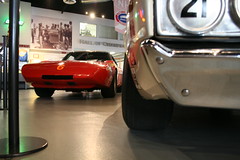
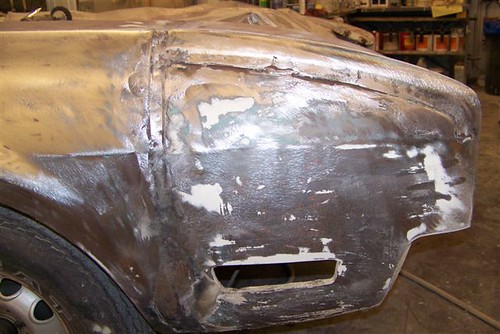
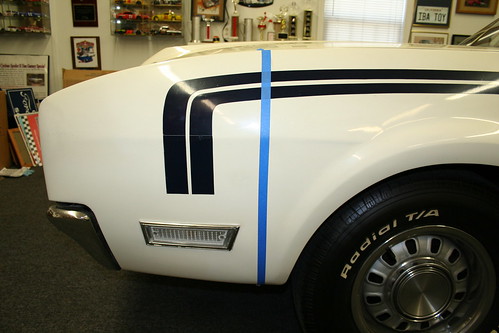
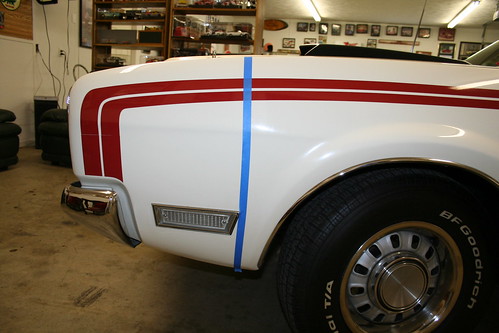
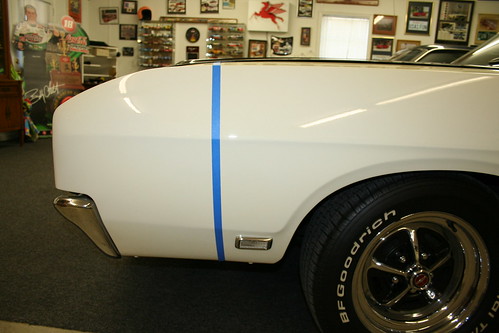
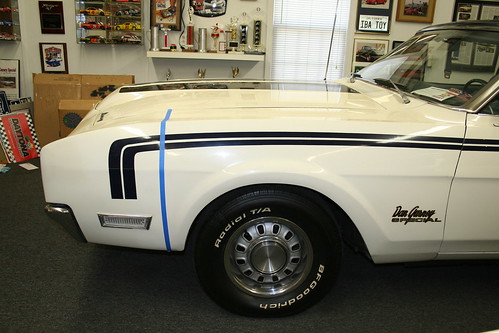

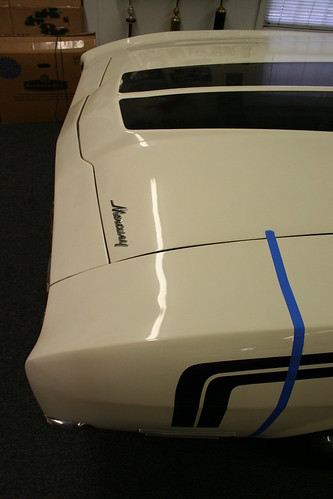
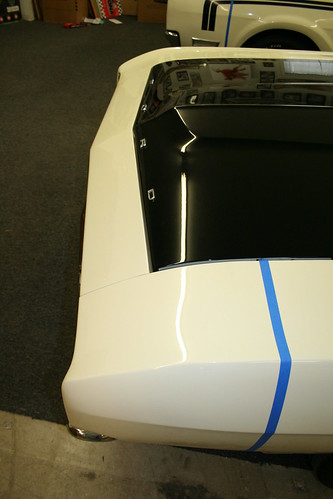
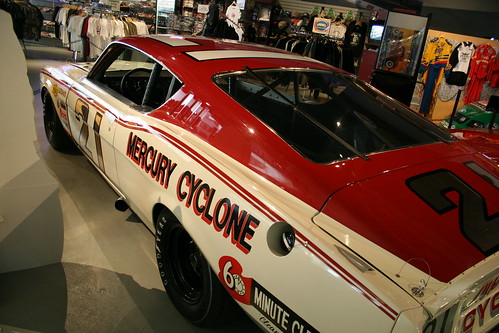

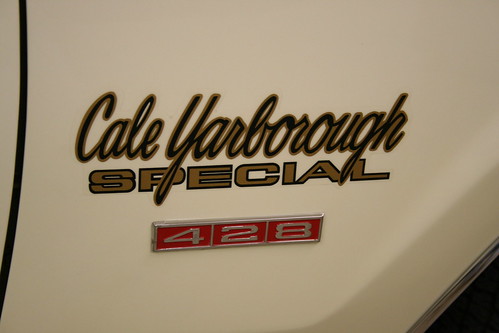

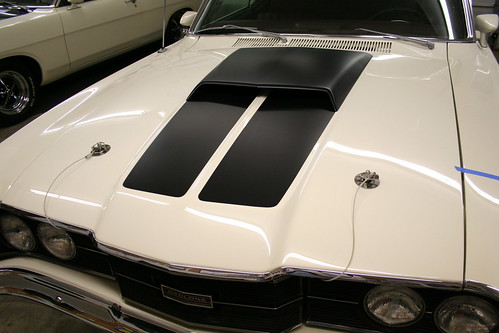
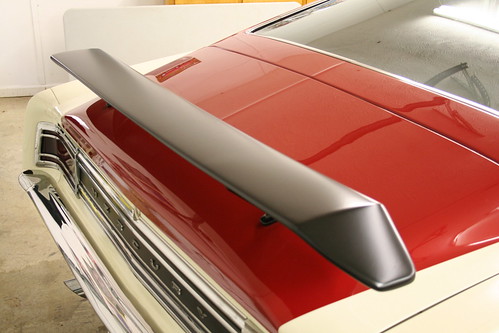
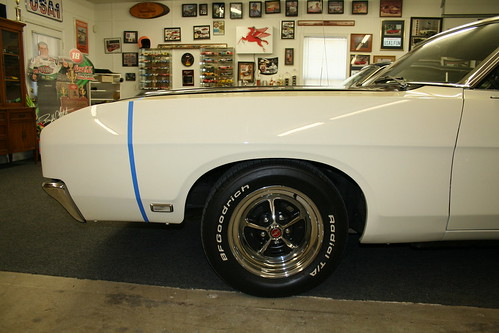

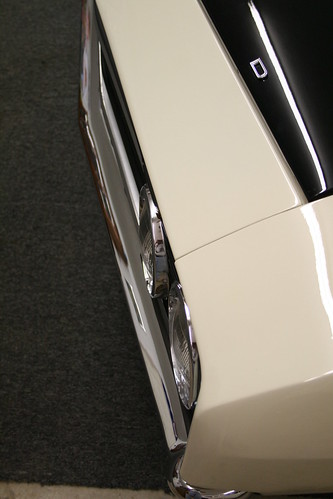

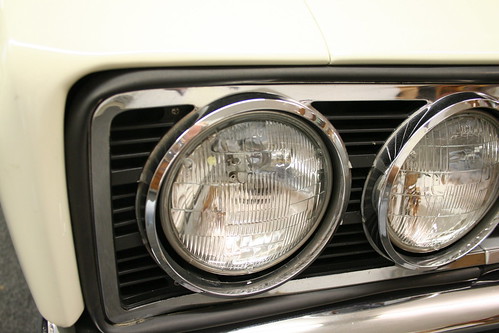

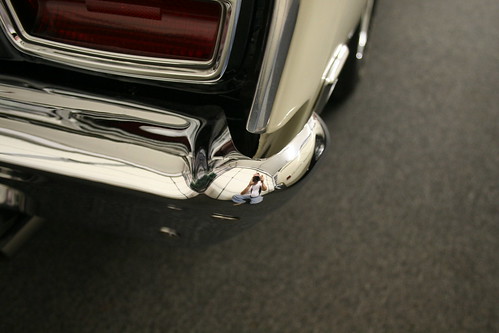
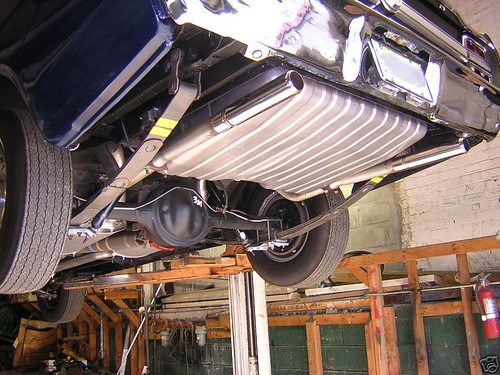
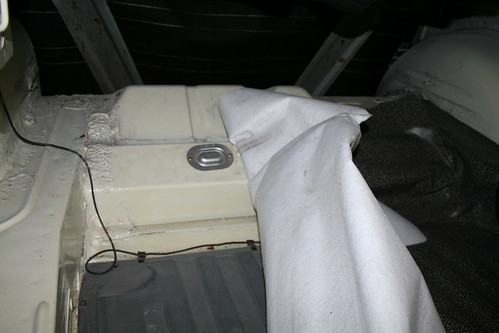




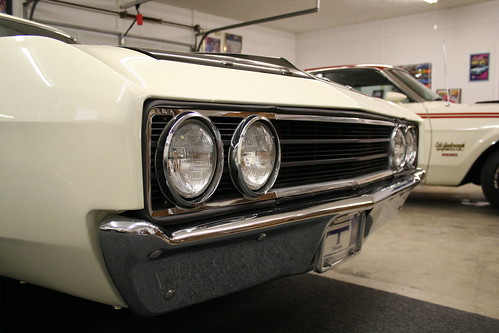

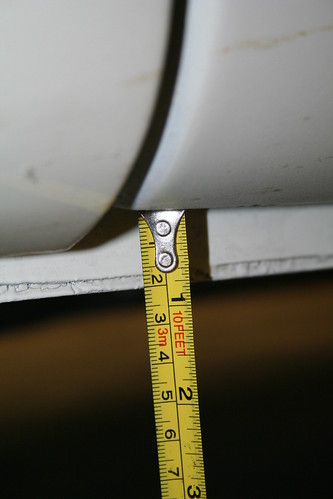
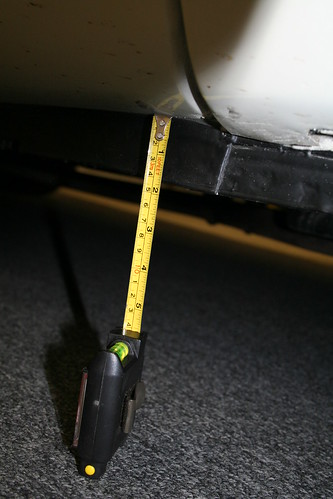
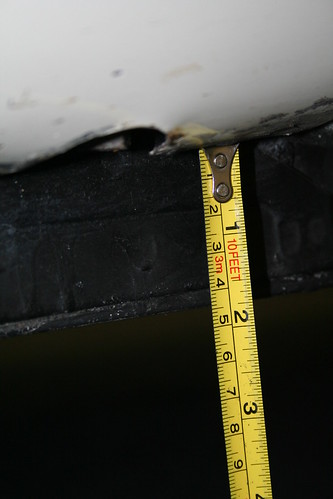
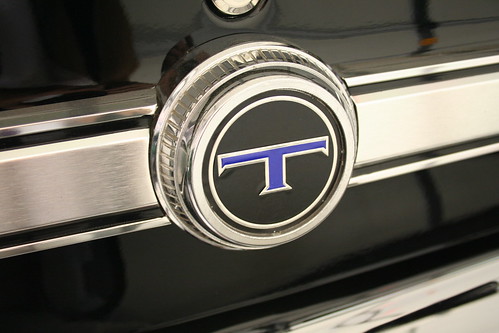
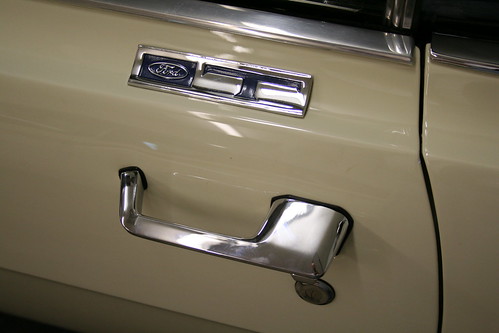
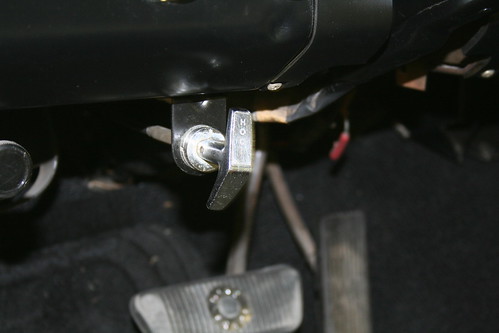

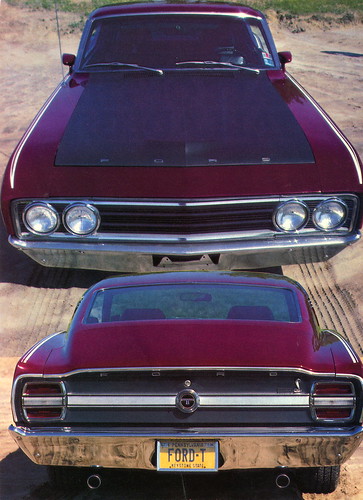

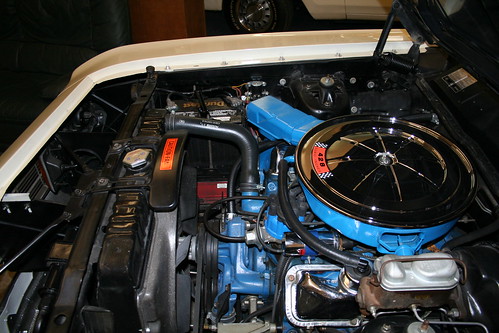
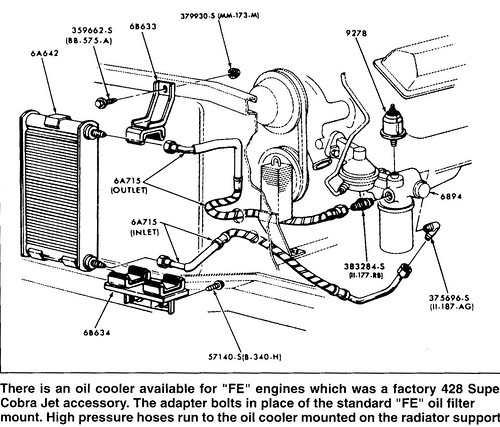

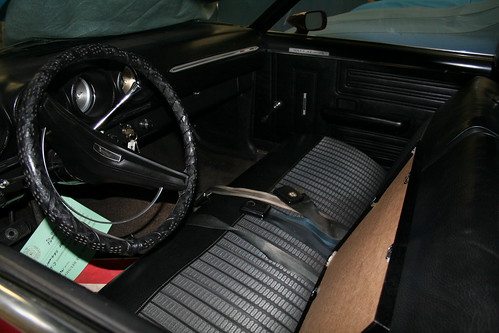
hey guys, I just read an article in muscle car review about a white 69 cyclone owned by Opie Willis and it says it is one of only 14 factory drag pack cars built? and it is the only white one.
I have a light ivy gold factory drag pack 69 cyclone that my dad bought new on 8/4/69 at raines linclon mercury in charleston wv
I am wondering where he got the numbers of only 14 built and his is the only white one?
please help
thanks Randy–cell# 304-982-9543
Randy, Have not seen the article but the best way to document a Ford of this vintage is with a Marti Report. There were certainly more than 14 Drag Pack cars built in 1869. However, what often happens with Marti Reports and some of the other companies that do other cars is they do a count based on how many cars of a certain model were built with certain options. By example they start by saying there were 50 ZYX Cars built with a certain engine and of those 50 were white; of those 24 had automatic transmissions and of those 2 had AM/FM radios and of those 2 only one had hub caps; This car is the one that had hub caps and the owner then brags he has A ONE OF ONE CAR! My guess is the guy has the only white car of 14 automatic Drag Pack cars or something similar. (yes, they did build automatic Drag Pack cars but no the automatics did not have staggered shocks.)
Richard,
Excellent info and pictures! Well done!
Thanks,
Carl.
killer info on these. my first car was a 68 cyclone, sure do miss it. im looking at a 69 428CJ cyclone, its a basket case and needs a front end. is there anyone reproducing the talladega front ends?
Thanks,
Awesome page. Its nice to find people who actually know about this car. Im about to begin restoration on my 69 cyclone and would like to ask you some questions about this process (where to find parts etc).
Thanks,
Frank
Frank, you might also like to check out our new site which is currently under construction but is dedicated to just these cars. It is http://www.TalladegaSpoilerRegistry.com Would you like to see the standard Cyclones added to the Registry?
Richard,
Iwould like to get in contact with Frank that just left a comment about his 69
mine is a w nose as I am starting the resto on mine as well
maybe we can locate some parts for each other
thanks
randy
Randy, for everyones security I can not give you someone else’s email address but I can give them yours. I will send it to Frank and have him get in contact with you if he is interested. You can also post a Free Wanted ad in our Classifieds. We will also be dealing with this issue on our other site in the Team Member Resources page once it is up and running you might want to join and give that a try.
I would like to see standard Cyclones added to the registry.
Making Talladega fenders, Mercury’s too. All the front end pieces for these cars. Also, Holman Moody air cleaners. Call Richard at (813)817-1963.